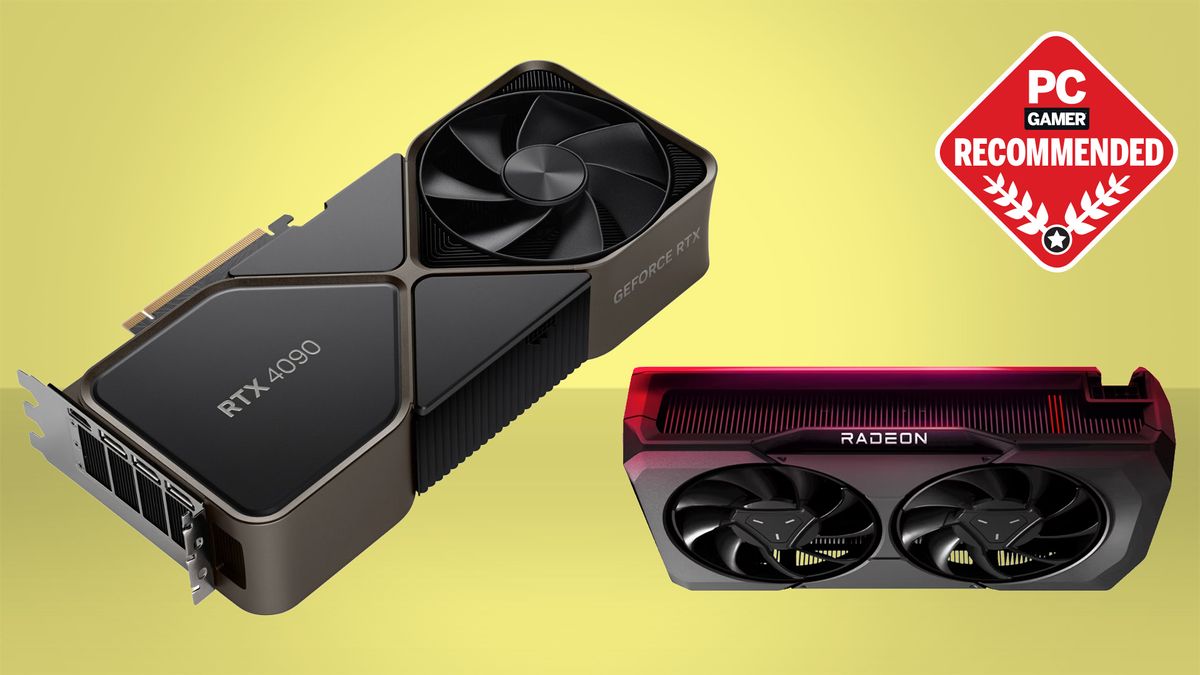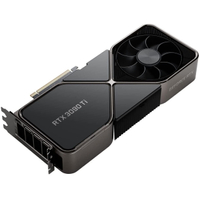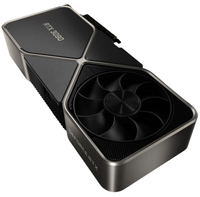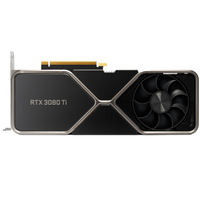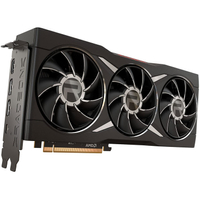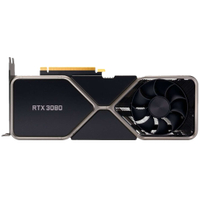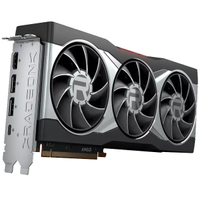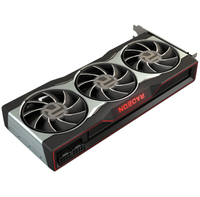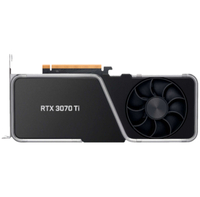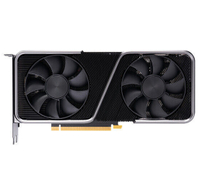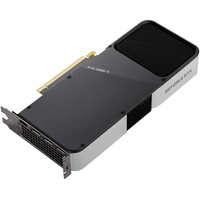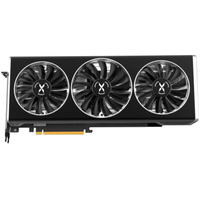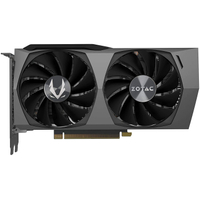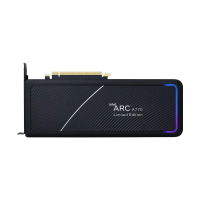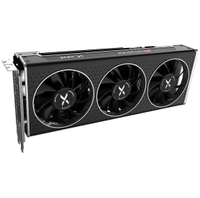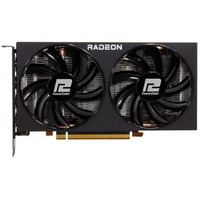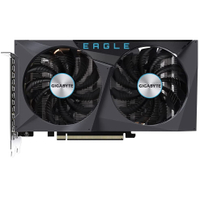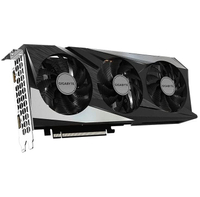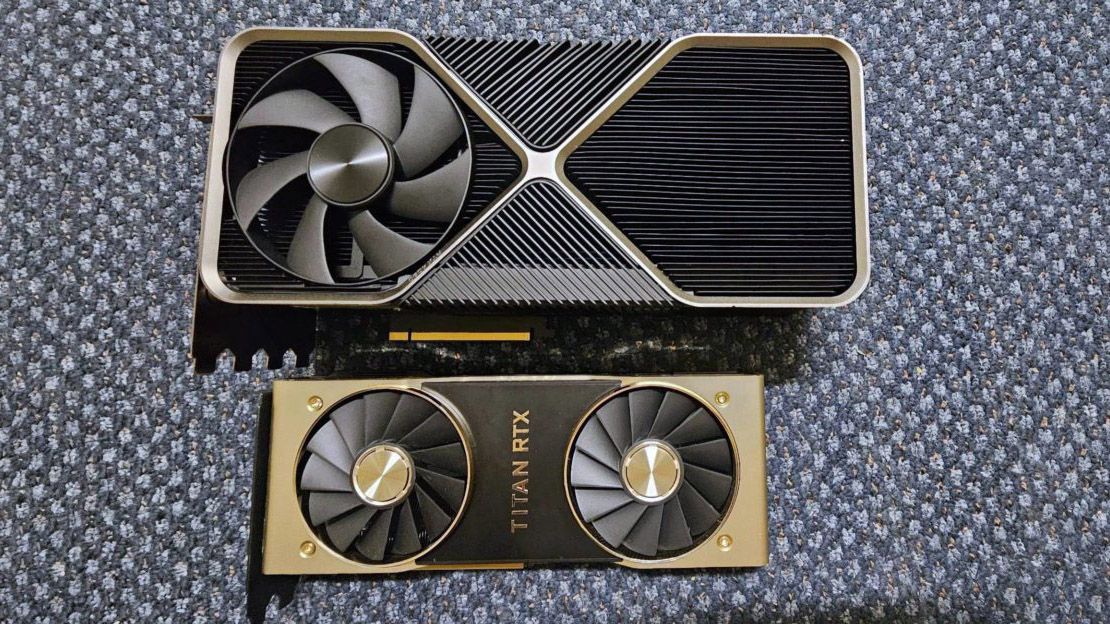Quick menu
🎮 The list in brief
1. Best overall
2. Best AMD
3. Best $500 – $600
4. Best $350 – $500
5. Best $250 – $350
6. Best budget
7. Also tested
8. GPU hierarchy
9. Price list
10. Where to buy
11. GPU FAQ
The best graphics card is objectively Nvidia’s RTX 4090. Subjectively, however, you’re going to want to weigh up the pros and cons of spending $1,600 or more on a single GPU. It’s not for everyone. That’s why we’ve tested every new GPU out of the Nvidia, AMD, and now Intel stables to find the best card across multiple price points. The results might surprise you.
For the high-end gamer, you’ve plenty of cards to choose from. Nvidia has its RTX 40-series led by the RTX 4090, and that thing really is a beast of massive proportions. No seriously, it’s huge. The RTX 4080 Super is pretty much the same as the old RTX 4080 it’s replacing, just with a $200 price cut. It’s also now offering just enough to tip the scales against the AMD RX 7900 XTX at this price point. There’s also now the RTX 4070 Ti Super and RTX 4070 Super, the former with a whole new GPU and more memory, and the latter with a hefty core count boost—all for the same MSRP as their forebears. AMD has responded with the RX 7900 Golden Rabbit Edition. It might have an odd name, but it’s very competitive against both RTX 4070 cards.
At the other end of the market, there’s not much new to write about. Nvidia has a rather uninspired upgrade in the RTX 4060, but for our money the best budget graphics card is the AMD Radeon RX 7600… even if we also met the release of AMD’s low-end RDNA 3 card with a shrug. At least it’s cheap enough now to feel more competitive. Intel still has a dog in the budget game: the Arc A750. When this card drops down to around $200, it’s a steal, though the drivers aren’t always up to the standard we’d like to see. That leaves AMD’s RX 7600 as the best budget GPU today, mostly for being a boringly safe pick.
We suggest avoiding the high-end RX 6950 XT and RTX 3090 Ti nowadays, as these cards are generally being pushed out by similarly priced newer options. The only last-gen card we still really rate is the RX 6700 XT, which still offers a decent spec and performance for $320. I’ve listed the specific graphics cards we recommend in different categories below, but I’ve also lined up the most relevant GPUs of this latest generation (with a few guest appearances by still worthwhile last-gen cards) all in order of gaming performance.
Curated byCurated byJacob Ridley
Jacob has loads of experience with the latest and greatest graphics cards, reviewing many generations of Nvidia and AMD GPU over the years. He’s au fait with the latest architectures, even Intel’s Arc, and makes sure to rotate through the latest cards from all three major manufacturers to get first-hand experience of what they’re like to game with. Not just of their performance, but also which offer the most useful features and have the most reliable drivers.
The quick list
Best overall
1. Nvidia GeForce RTX 4090
The best overall GPU
The RTX 4090 is where it’s at. This is the graphics card that truly represents a genuinely next-generation experience. It’s also the most expensive card. Although, if you take inflation into account, it’s arguably cheaper than the RTX 3090 was.
Best AMD
2. AMD Radeon RX 7900 XTX
The best AMD GPU
AMD has managed a supremely impressive feat with the RX 7900 XTX: it has managed to make the first generation of chiplet GPU actually work, and work at the high end. Sometimes it beats the RTX 4080, and for a good chunk less cash, too.
Best $500 – $600
3. Nvidia GeForce RTX 4070 Super
The best $500 – $600 GPU
The first of Nvidia’s refreshed Ada GPUs is also the one which has had the biggest core count boost. That makes it clearly superior to the original RTX 4070 for the same money. It’s faster than both that cheaper GeForce and AMD RX 7900 GRE, though they remain tempting alternatives.
Best $350 – $500
4. AMD Radeon RX 7800 XT
The best $350 – $500 GPU
A very good graphics card for non ray-traced gaming, and the highest performance from a sub-$500 card. But with a multi-chip GPU that isn’t moving the game forward, all it really has over the competition and its last-gen stablemate is that lower price.
Best $250 – $350
5. AMD Radeon RX 6700 XT
The best $250 – $350 GPU
The RX 6700 XT has transformed into a great value card, making things rather tough for the RTX 4060 Ti. It’s RDNA 2 design lacks the panache of Nvidia’s DLSS 3 and Frame Gen tech, but there’s a lot of graphics card here for its sub-$350 price-point.
Best budget
6. AMD Radeon RX 7600
The best budget GPU
The AMD Radeon RX 7600 has its share of positives, and it offers good value for money for long suffering gamers. However, it doesn’t do enough to excite, and it faces tough competition from all sides.
Recent updates
Updated February 28th to add the new AMD RX 7900 GRE that has just been released to the full review list, but the main recommendations for the best graphics cards overall and at different price points remain the same. We have also added relative benchmarks across a suite of different games for every GPU in the list.
Nvidia GeForce RTX 4090
Nvidia GeForce RTX 4090
Our expert review:
Specifications
Shaders: 16,432Boost clock: 2,520MHzTFLOPs: 82.6Memory: 24GB GDDR6XMemory clock: 21GT/sMemory bandwidth: 1,008GB/sTGP: 450W
Reasons to buy
+Excellent gen-on-gen performance+DLSS Frame Generation is magic+Super-high clock speeds
Reasons to avoid
-Massive-Ultra-enthusiast pricing-Non-4K performance is constrained-High power demandsBuy if…
✅ You want the best: The RTX 4090 is simply the most powerful GPU you can buy for your gaming PC today. The silicon inside it is monstrously powerful, and along with DLSS3 and Frame Generation it provides a truly next-gen experience.
✅ You want to nail 4K gaming: This is the card that makes 4K gaming buttery smooth. That 24GB frame buffer means you’re not going to run out of VRAM any time soon.
✅ You’re a creator as well as gamer: Time is money if you do any sort of professional GPU work, and the RTX 4090 could start to pay for itself right away given its rendering and compute power.
Don’t buy if…
❌ You need to ask the price: It’s fair to say that it’s one of the best value Ada GPUs given its relative price performance ratio, but it’s still $1,600 at best. Still, it’s far cheaper than the RTX 3090 Ti was, and the RTX 3090 if you take inflation into account.
❌ You have a compact rig: This thing is BIG. Like, comically big.
The bottom line
🪛 The RTX 4090 is the true next-gen experience that we simply haven’t seen from any of the other AMD or Nvidia cards from this new generation. And that almost makes it worth that exorbitant price tag.
There’s nothing subtle about Nvidia’s GeForce RTX 4090 graphics card. It’s a hulking great lump of a pixel pusher, and while there are some extra curves added to what could otherwise look like a respin of the RTX 3090 shroud, it still has that novelty graphics card aesthetic.
It looks like some semi-satirical plastic model made up to skewer GPU makers for the ever-increasing size of their cards. But it’s no model, and it’s no moon, this is the vanguard for the entire RTX 40-series GPU generation and our first taste of the new Ada Lovelace architecture.
On the one hand, it’s a hell of an introduction to the sort of extreme performance Ada can deliver when given a long leash, and on the other, a slightly tone-deaf release in light of a global economic crisis that makes launching a graphics card for a tight, very loaded minority of gamers feel a bit off.
But we can’t ignore it for this guide to the best GPUs around simply because, as it stands today, there’s no alternative to the RTX 4090 that can get anywhere close to its performance. It’s unstoppable, and will stay ahead of the pack as we now know AMD’s highest performance graphics card, the RX 7900 XTX, is well and truly an RTX 4080 competitor.
This is a vast GPU that packs in 170% more transistors than even the impossibly chonk GA102 chip that powered theRTX 3090 Ti. And, for the most part, it makes the previous flagship card of the Ampere generation look well off the pace. That’s even before you get into the equal mix of majesty and black magic that lies behind the new DLSS 3.0 revision designed purely for Ada.
Look, it’s quick, okay. With everything turned on, with DLSS 3 and Frame Generation working its magic, the RTX 4090 is monumentally faster than the RTX 3090 that came before it. The straight 3DMark Time Spy Extreme score is twice that of the big Ampere core, and before ray tracing or DLSS come into it, the raw silicon offers twice the 4K frame rate in Cyberpunk 2077, too.
There’s no denying it is an ultra-niche ultra-enthusiast card, and that almost makes the RTX 4090 little more than a reference point for most of us PC gamers. We’re then left counting the days until Ada descends to the pricing realm of us mere mortals, which is still yet to happen despite the launch of the RTX 4070 Ti.
In itself, however, the RTX 4090 is an excellent graphics card and will satisfy the performance cravings of every person who could ever countenance spending $1,600 on a new GPU. That’s whether they’re inconceivably well-heeled gamers, or content creators not willing to go all-in on a Quadro card. And it will deservedly sell, because there’s no other GPU that can come near it right now.
Read our full Nvidia GeForce RTX 4090 review.
Nvidia GeForce RTX 4080 Super
Image 1 of 6
Nvidia GeForce RTX 4080 Super
Essentially the same RTX 4080 card, but with the $999 sticker price we wanted all along.
Our expert review:
Specifications
Shaders: 10240Boost clock: 2,550MHzTFLOPs: 58Memory: 16GB GDDR6XMemory clock: 23GT/sMemory bandwidth: 736GB/sTGP: 320W
Reasons to buy
+Priced at a more understandable level+Great gaming performance+Super efficient GPU
Reasons to avoid
-Still priced too high-No tangible performance gains over RTX 4080-AMD’s RX 7900 XTX remains stiff competitionBuy if…
✅ You can find an MSRP card:The price cut is the real strength of the Super variant, and that benefit diminishes if you can only find cards north of $1,000 to buy.
✅ You want good 4K ray traced gaming performance:Ada is efficient and really good at dealing with the rigours of ray tracing. Add DLSS and Frame Generation to the mix and the RTX 4080 Super excels at delivering solid 4K frame rates.
Don’t buy if…
❌ Ray tracing means nothing to you:In pure rasterised gaming terms, the RX 7900 XTX from AMD can often outperform the RTX 4080 Super, and that makes it a very tempting option, especially if you can find one cheaper than the Nvidia card.
The bottom line
🪛 The RTX 4080 Super is a far more tempting prospect now it’s had a $200 price cut. That brings it to the same price as the AMD 7900 XTX, and the balance of features and ray tracing performance brings us down on the side of Nvidia. Now the RTX 4090 is getting ludicrously expensive, it’s becoming the top GPU you can legit buy today.
Less is more, right? I mean, technically the RTX 4080 Super is actually more is less when you consider you’re now getting the full AD103 GPU for less cash. But it’s the pricing change which is the real kicker for the new second-tier Ada card as it’s the only tangible difference.
Though it’s not like you’d ever need to weigh up the differences between the RTX 4080 and the RTX 4080 Super; the older version has effectively been killed and it’s just the overpriced legacy cards getting ever more dusty as they sit, unloved and unwanted, on the shelves of any retailer unlucky enough to still be holding onto stock.
So, it’s all about weighing up how much of a difference that price cut has made to the positioning of the RTX 4080 Super. And honestly, it’s not as much as I’d want. Even this $999 price should have been the absolute upper limit on the ludicrous overclocked, liquid-chilled versions from GeForce board partners, not the straight MSRP of Nvidia’s second-tier RTX 40-series card.
That a year after launch the price of the RTX 4080 has only now dipped below $1,000 (around Black Friday last year we sawthe first card to drop that low), and now this Super version is starting there, well, it’s all very welcome. Though I just can’t find myself getting too excited about moderately lower pricing that still feels like it’s far too much.
But we can’t get too bent out of shape over what might have been; this is about the product I have in front of me, and the RTX 4080 Super is the same super-powerful graphics card it was 14 months ago when its progenitor launched. It’s a card which makes the once top GPU of the Ampere age look utterly laggardly—and incredibly inefficient—by comparison. Now, at $999, it looks even better put up against the $1,500RTX 3090of the previous gen.
The price cut and slight performance bump does also now make it tougher for AMD’s best RDNA 3 card by comparison, though it is still very tight. Our two original referenceRX 7900 XTXcards were beset by thermal issues and performed very badly, but third party cards, and subsequent driver improvements, resulted in aRadeonGPU that was generally priced below the $1,200 RTX 4080 but in pure raster terms often outperformed it.
Now, with a solid $999 MSRP, the RTX 4080 Super doesn’t change the game in terms of comparative performance—on average 2% slower at 4K settings—but it does make it generally cheaper than the speedy third-party OC RX 7900 XTX cards. With the Nvidia card often faster with ray tracing games, and the AMD speedier in purely rasterised games, I’d say it kinda all evens out. But with the weight of ecosystem behind it, that just about swings it for the RTX 4080 Super; the extra AMD memory capacity doesn’t make a big difference in gaming terms for me.
But it is still a close run thing, and I certainly wouldn’t begrudge anyone picking the RX 7900 XTX over the latest GeForce GPU if they could find it for less.
Though after a year of reportedly poor RTX 4080 sales—and worse press around its launch and pricing—the RTX 4080 Super does feel like a pretty successful relaunch. It’s got a pretty new shroud, as good an AD103 GPU as it could jam in there, and the same great performance but for a lower price.
RTX 4080 rehabilitation, done.
Read the full Nvidia RTX 4080 Super review.
Nvidia GeForce RTX 4080
Image 1 of 5
Nvidia GeForce RTX 4080
At $999 it would have been a great high-end gaming GPU
Our expert review:
Specifications
Shaders: 9728Boost clock: 2,505MHzTFLOPs: 48.8Memory: 16GB GDDR6XMemory clock: 22.4GT/sMemory bandwidth: 717GB/sTGP: 320W
Reasons to buy
+Bests both the RTX 3090 and 3080 Ti+Has the glitzy Frame Generation magic+Svelte, efficient GPU
Reasons to avoid
-Over-priced-Over-sizedBuy if…
✅ You find a discount: At its $1,200 price it’s a poor deal, but if you can find the RTX 4080 below $999 it might be worth a punt for the serious gaming performance it offers.
Don’t buy if…
❌ You can realistically afford the RTX 4090: If you’re seriously considering $1,200+ an okay spend on a GPU, have a think if you could stretch to an RTX 4090 because it’s a significantly better card, more so than the ~$400 difference.
❌ Space is a premium: It’s the same size as the RTX 4090, and by that I mean it’s absolutely ENORMOUS. Think seriously about the size of your case before you hit the buy button.
The bottom line
🪛 The RTX 4080 is almost impossible to recommend at its $1,200+ price point. At $999 or under it becomes a lot more tempting owing to its seriously impressive performance, and DLSS 3 support. Right now, though, it’s hugely overpriced.
The Nvidia RTX 4080 is another speedy graphics card—it bloody should be for $1,200—and when you take DLSS 3 into account you are getting on for twice the performance of the similarly pricedRTX 3080 Tifrom the last generation. Seriously, Frame Generation is black magic.
But reviewing the RTX 4080 is tougher than being Jen-Hsun’s spatula wrangler. Though it’s a lot more straightforward now there’s only a 16GB version and it doesn’t come with some additional 12GB half breed trailing it around.
During a time of extreme economic difficulty and uncertainty across the globe, it’s not a great look for both the main GPU makers to reveal their next generation graphics cards with the starting price being $900 at best. There will be arguments the $1,200 RTX 4080’s performance over and above the RTX 3080 Ti renders it an unqualified success. But I have thoughts on that, too.
The RTX 4080 comfortably outperforms the similarly priced cards from the previous generation, most notably the $1,200 RTX 3080 Ti, and therefore is really hitting that gen-on-gen performance uplift we crave. But neither these GeForce cards should ever have been a $1,200 GPU.
Nvidia has pared the silicon back a whole lot to create the AD103 GPU in comparison to the AD102 chip of the RTX 4090. Generalising, it’s 60% the size, has 60% of the transistors, and 60% of the CUDA cores, and yet is 75% of the price of the RTX 4090. If you wanted to do some simple maths the RTX 4080 really ought to be around $960.
But thanks to the abortive decision to launch with a pair of RTX 4080 cards at $1,200 and $899 respectively—with different levels of memory andwhollydifferent GPUs—Nvidia was locked into this price even once it unlaunched the cheaper 12GB card.
How does it stack up against the Radeon RX 7900 XTX? We’re looking at a very close-run thing. The AMD card performs at a roughly similar level to the RTX 3090, and for a $999 card that would make it tempting compared to a slightly quicker $1,200 RTX 4080, especially with its improved ray tracing capabilities.
AMDdoeslose on performance for the most part but sits comfortably lower in terms of pricing.
Read our full Nvidia GeForce RTX 4080 review.
AMD Radeon RX 7900 XTX
Image 1 of 6
AMD Radeon RX 7900 XTX
Our expert review:
Specifications
Shaders: 6144Boost clock: 2,500MHzTFLOPs: 61.4Memory: 24GB GDDR6Memory clock: 20GT/sMemory bandwidth: 960GB/sTGP: 355W
Reasons to buy
+Much faster than an RX 6950 XT at 4K+Less power hungry too+$999 price tag+Much improved ray tracing capabilities+Frickin’ chiplets!
Reasons to avoid
-Not a consistent RTX 4080 competitor-Runs real hot-Consumes a lot of power-Low average clock speedBuy if…
✅ You want the best AMD can offer: This is the pinnacle of AMD’s RDNA 3 technology right now, and the fact the red team has got a chiplet GPU running so well in its first generation is really impressive.
✅ You need a lot of video memory: With a full 24GB of GDDR6 at its disposal, for a lot less than the RTX 4090, the RX 7900 XTX has a lot to offer the creator.
✅ Ray tracing’s not for you: If you care not a jot for ray tracing, the raster performance of the Navi 31 GPU is excellent. It has improved RT skill compared with AMD’s last generation, but it’s still behind Nvidia on that score.
Don’t buy if…
❌ The AMD reference card is the only option: Normally we’re big fans of both AMD and Nvidia’s reference cards, but the RX 7900 XTX has a heat issue with the reference cooler not found on third-party versions. We’ve experienced the problem on both the review cards AMD provided for testing.
❌ You’re looking for consistent RTX 4080 performance: We’d hoped for a more regularly competitive gaming experience from the RX 7900 XTX, but sometimes it’s a long way behind Nvidia’s second-tier card.
The bottom line…
🪛 As the finest Radeon ever made, the AMD RX 7900 XTX has a lot going for it. If it was closer to the RTX 4080 in gaming terms, more regularly, we’d have no hesitation recommending this top red team GPU.
Our review RX 7900 XTX sample suffered from anissue with GPU hotspot temperaturesexceeding the normal expected range under load. We’ve since been in contact with AMD about a replacement for retesting, which we’ve since received, but unfortunately we’ve had the same issue strike again. Fun, eh?
You can check out our reviews for theAsus TUF Gaming Radeon RX 7900 XTX OC EditionandSapphire Nitro+ RX 7900 XTX Vapor-X, as these cards are entirely unaffected by the issue and better show what sort of performance you can expect from this card’s spec. The benchmark numbers above for the top AMD card are from the excellent Sapphire Nitro+ version.
Still, the AMD Radeon RX 7900 XTX has a lot going for it. We’re used to seeing GPU generations that arrive on smaller process nodes, redesigned architectures, larger caches, reworked shaders, more memory—the list goes on. But all of that, all at once? That’s what RDNA 3 delivers: the whole lot in one fell swoop.
The RX 7900 XTX is a superb 4K GPU at its original $999 price tag. It’s ruling its own segment of the market, and it offers a significant performance boost over what RDNA 2’s could muster in the ~$1,100 RX 6950 XT or $999RX 6900 XT. It’s expensive, but not any dearer than the card it replaces.
Admittedly the RX 6950 XT is nowhere near its full price today, more like $800 or less. Though the RX 7900 XTX has enough pace to justify its price tag. You’re paying around 20% more than an RX 6950 XT as it stands today for a card that generally outperforms it by 20% or, on a few occasions in my benchmarking, a whole lot more.
The increase in memory capacity from 16GB to 24GB with the RX 7900 XTX is a bonus, and the ray tracing performance on RDNA 3 is much more convincing to make me part with my money.
Yet as an RTX 4080 competitor the RX 7900 XTX is less convincing. It’s rarely able to match the RTX 4080. The RTX 4080 is up to 28% faster in my testing, though it’s more like 15% on average. For an RTX card that asks at least 20% more cash than the RX 7900 XTX, that stat is not a dealbreaker, but it does make the XTX’s gains more moderate by comparison. What helps the XTX’s value proposition is that it has more memory and, on rare occasions, actually beats the RTX 4080. If you’re only playing Far Cry 6 then you’re laughing with an XTX, but let’s be honest, you’re not.
This leaves Nvidia with rule of the ultra-high-end segment. But AMD has played the hand dealt to it by Navi 31’s performance here. It has a card that’s not regularly outperforming the RTX 4080, but it’s notably cheaper. That absolutely brings the XTX back into consideration at the $1,000 mark.
If the $999 price tag on the RX 7900 XTX can meaningfully stick around for a while, and by that I mean you have to be able to buy this card for that price tag or similar, the RX 7900 XTX will exist as a great 4K graphics card for an ultra high-end PC build in 2024. Yes, there are better, and the RTX 4090 is now undeniably the top dog for gaming, but It’s all about weighing up what you really need and what you can afford—i.e. probably not an RTX 4090.
Combined with a high-end CPU and a 4K (or ultrawide) monitor, you’ll net superb frame rates with the RX 7900 XTX in your build for potentially half the price.
Read our full AMD Radeon RX 7900 XTX review.
AMD Radeon RX 7900 XT
Image 1 of 5
AMD Radeon RX 7900 XT
Our expert review:
Specifications
Shaders: 5376Boost clock: 2,400MHzTFLOPs: 51.6Memory: 20GB GDDR6Memory clock: 20GT/sMemory bandwidth: 800GB/sTGP: 315W
Reasons to buy
+Faster than an RX 6950 XT+Great design and cooling+Lots of memory+Slightly cheaper than RX 7900 XTX
Reasons to avoid
-RX 7900 XTX is too close for comfort-Quite power hungryBuy if…
✅ The price keeps dropping: At launch its $899 sticker price was too close to the superior RX 7900 XTX, but now it’s creeping well below $800 it’s becoming a more tempting 20GB GPU option.
Don’t buy if…
❌ You value Nvidia’s DLSS 3 and Frame Generation tech: At more or less the same price as the RTX 4070 Ti, and trading blows at standard raster frame rates, the actually tangible benefits of the complete DLSS 3 package can make a difference.
The bottom line
🪛 The AMD RX 7900 XT makes things a little more uncomfortable for both the RTX 4070 Ti and RX 7900 XTX because it’s now the same price as the former, and considerably cheaper than the latter.
AMD’s Radeon RX 7900 XT is a slightly slimmed back version of the Navi 31 GPU and the company’s top graphics card, the RX 7900 XTX. Starting at $899, now dropping below $800, it’s therefore offering a slightly cheaper way into the RDNA 3 generation, you could also be forgiven for thinking it’s not that much cheaper than the best. The RX 7900 XTX is priced tantalisingly close at $999. So why would you pick up the cheaper chip of the two? That’s a good question, and I’m not sure I have a good answer apart from price.
The RX 7900 XT outperforms AMD’s previous top card, the RX 6950 XT, in every benchmark I tested and by a good margin, too. Considering the RX 6950 XT launched at over $1,000, and now sits around $800, maybe less, that’s a point of pride for the RX 7900 XT.
Overall, I’d say there are a few things the RX 7900 XT does well. For starters, it appears to be a good upgrade on even the RX 6950 XT, and considering the price difference between the two at launch, that’s a good sign of AMD’s progression with the RDNA 3 architecture. The reference cooler on this also seems pretty capable for the price, with temperatures running relatively cool considering its performance.
There are a few times when the differences between the XT and XTX are minimal, and the performance delta practically non-existent. The XT is also the much more efficient and cooler running of the two. Generally, though, you get what you pay for with the higher-end XTX card, if not a bit more.
Is it better than an RX 6950 XT? Yes. Cheaper than an RX 6950 XT at launch? Yes. An RTX 4080 competitor? Nope. Is it worth saving your money on this instead of the XTX? Probably not. It’s a good 4K graphics card if you look at the frame rates in isolation, but with a generally much better card right there for the taking, you best believe I’m going to want to find the extra $100 somewhere in my build and pick up the XTX instead.
Read our full AMD Radeon RX 7900 XT review.
Nvidia RTX 4070 Ti Super
Image 1 of 6
Nvidia GeForce RTX 4070 Ti Super
Arguably the most interesting Ada refresh GPU
Our expert review:
Specifications
Shaders: 8,448Boost clock: 2,610MHzTFLOPs: 49.83Memory: 16GB GDDR6XMemory clock: 21GbpsMemory bandwidth: 672GB/sTGP: 285W
Reasons to buy
+A healthy performance upgrade without a price increase+Memory system upgrade+Excellent efficiency+Runs cool
Reasons to avoid
-Avoid the MSI Ventus… at least in the short term-A few extra shaders would have been niceBuy if…
✅ You’re upgrading from an RTX-20 series or older card: An upgrade from one of the contemporarily excellent xx70 cards of yesteryear will bring you a dramatic performance uplift, not to mention the ‘free’ boost that DLSS3 and Frame Generation will deliver.
✅You want the security of having a card with 16GB of VRAM:Forget the RTX 4060 Ti 16GB. This is the Nvidia card to get right now if you want that extra bit of life. With the likes of Grand Theft Auto 6 yet to come, it’ll be better to have too much VRAM in the years ahead than not enough.
Don’t buy if…
❌You already have a non-Super RTX 40-series card:The Super refreshes, while welcome, aren’t enough of an upgrade over non-Super counterparts to justify going out and dropping another wad of cash on one.
❌The RTX 4070 Super drops further in price:The RTX 4070 Super is a full $200 less than the RTX 4070 Ti Super. Should it drop to $549 or lower, it’d become hard to ignore.
The bottom line
🪛 I would have hoped for more of a performance difference with the RTX 4070 Ti Super considering it’s using the bigger GPU. But even if it’s only 10-15% quicker than the RTX 4070 Ti, it’s still the card I’d want for the memory increase and bigger GPU on the whole.
The mid-life RTX 4070 Ti Super refresh addresses the concerns we had when the initial line-up went on sale. With the RTX 4070 Ti Super, any worries over weak memory specifications are put to rest. It’s the RTX 4070 Ti we really wanted, and it would have most likely ended up as our pick of the initial generation assuming it had still launched at $799.
At just over half the price of the formerly mighty RTX 3090, while handily beating it, the RTX 4070 Ti Super is the perfect advertisement for an intergenerational performance improvement. If it beats out the RTX 3090, just imagine the kind of upgrade it will deliver for owners of popular cards like the GTX 1070 and RTX 2070. Add to that the benefits of DLSS 3 and Frame Generation and gamers looking for an upgrade that’s a big step above the likes of the RTX 4060 Ti will be very happy.
TheAMD RX 7900 XTremains a good competitor, especially after itsrecent price drop. However, AMD’s challenger still lags on ray tracing performance, and it’s now lost its VRAM advantage. AMD’s FMF frame generation technology is in its nascent stages, so the jury remains out on that. It will be interesting to see if there’s a further price battle between the RTX 4070 Ti Super and the RX 7900 XT. There is a bit of a gap between them and the $599 RTX 4070 Super and the $499RX 7800 XT, so there is some potential breathing room.
Before I get too far into the meat of this review, there is something that needs attention. This is the asterisk under the headline up top. On the day before our review was due to go live, Nvidia informed us of a BIOS issue with MSI’s Ventus card. This issue can lead to a loss of up to 5% of performance. An updated BIOS was provided, but even this BIOS still suffered from a reported 3% loss of performance. MSI has now released a vBIOS fix which reportedly elevates “the overall performance of the graphics card to be in line with our expectations.”
But with stock already sitting in warehouses, it’s a struggle to recommend the MSI RTX 4070 TI Super Ventus right now when users are likely going to have to be very wary of what vBIOS version is on their board and deal with the sometimes scary (though honestly super straightforward) trial of updating the BIOS of their new GPU.
I would still suggest, however temporary these issues have been, RTX 4070 Ti Super early adopters will want to look at another manufacturer, at least if you’re not comfortable updating a graphics card BIOS yourself. For me, they’d have to be far cheaper than the competition to make me consider the MSI right now. Nvidia, for its part, has said the likes ofAsus‘ TUF version offer standard RTX 4070 Ti Super performance out of the box.
If you skip the MSI, there will be a whole range of MSRP cards launching on day one, with overclocked models to follow. Graphics card manufacturers have a lot of experience when it comes to taming cards with much higher power and thermal demands, so really, any of the basic RTX 4070 Ti Supers will deliver nearly identical performance. The dual fan ones might require a bit higher fan speed and hence noise levels to maintain higher boost clocks but, in the end, aesthetics and brand loyalty (if any) will be the main differentiators.
High refresh rate 1080p and 1440p gaming is a breeze with the RTX 4070 Ti Super. Throw in the benefits of excellent performance per watt, a forward looking 16GB of VRAM, Nvidia’s AI and creative tools, plus the ability to game with lots of eye candy with DLSS 3 and Frame Generation at 4K and suddenly $799 looks a fair price. Make it $749 or a smidgen lower, and we’d be really stoked.
Read our full Nvidia RTX 4070 Ti Super review.
Nvidia RTX 4070 Ti
Image 1 of 7
Nvidia GeForce RTX 4070 Ti
Our expert review:
Specifications
Shaders: 7,680Boost clock: 2,610MHzTFLOPs: 40.1Memory: 12GB GDDR6XMemory clock: 21GbpsMemory bandwidth: 504.2GB/sTGP: 285W
Reasons to buy
+RTX 3090-level performance+Frame Generation remains a potent weapon+Cool-running+Very efficient
Reasons to avoid
-Weak memory system-More expensive than we’d likeBuy if…
✅ You lusted after an RTX 3090 for gaming: With RTX 3090-level gaming frame rates, the RTX 4070 Ti is almost a good-value GPU at its $799 price point.
Don’t buy if…
❌ $800 is too rich for your blood: If you’re considering selling a kidney, hold that thought. The RTX 4070 is considerably less expensive and is only around 25% slower. And remember 25% slower still means really high 1440p and even 4K frame rates.
The bottom line
🪛 It’s a good card, but like almost every Ada GPU, the RTX 4070 Ti still feels like a price tier too high to feel like a true generational uplift. The RX 7900 XT is also almost the same price now, and sometimes quicker, and the RTX 4070 not a lot slower for less.
The unlaunching and subsequent rebadging and repricing of the RTX 4080 12GB was the best thing to happen to this third-tier Ada GPU. Now and forever to be known as the RTX 4070 Ti, this is the card that now makes it impossible to recommendAMD’s RX 7900 XT.
Possibly the most impressive thing to say about the RTX 4070 Ti is that very regularly it’s level to, or faster than an RTX 3090. When you think that’s the $1,500 GPU of the last generation that looks like a great gen-on-gen uptick in performance, especially when that’s at the top 4K resolution.
What’s maybe less exciting is that, when you’re just talking in straight rasterized gaming terms, it’s not a whole lot faster than the old, cheaper RTX 3080 10GB at 4K. Itisfaster, most especially when you bring those third gen RT Cores into the equation, but it’s clear the higher clocks and heftier L2 cache is having to work hard to give it the lead in raw frame rate terms over the older Ampere card.
Where it looks far more positive is up against the new AMD RDNA 3 cards, the RX 7900 XTX and RX 7900 XT. It is generally slower than the top Radeon GPU, but against the still more expensive RX 7900 XT the RTX 4070 Ti regularly posts higher 4K performance.
Without any of the DLSS 3/Frame Gen stuff in attendance the RTX 4070 Ti is a very capable performer, but once again the power of Nvidia’s upscaling tech is preposterously good. I keep trying to see where the Frame Generation technology fails but I can’t do it. Every time I’m like ‘aha, there it is, the tell-tale artefact of fake AI frames!’ I then check out the native rendering and it looks exactly the same. If not worse.
And with the extra genuine performance of the upscaled frames and the interpolated smoothness of the AI-generated frames, the performance improvement is spectacular where DLSS 3 is available. Which should be more and more often, with Nvidia’s Streamline SDK offering devs a one-stop option for enabling it and other vendors’ upscaling tech too.
In gaming terms, the 4K performance of the RTX 4070 Ti is impressive even without upscaling, and is rather astounding with it.
There’s definitely an argument to be made that in its own price bracket the RTX 4070 Ti is a better option for anyone looking to spend the best part of a grand on their new GPU. With its lower price point the RTX 4070 Ti makes more sense than it did as an RTX 4080 at $899, and with RTX 3090-level gaming performance there’s a lot of power under that triple-fan shroud.
Read our full Nvidia GeForce RTX 4070 Ti review.
Nvidia GeForce RTX 4070 Super
Image 1 of 6
Nvidia GeForce RTX 4070 Super
The RTX 3080 Ti replacement service
Our expert review:
Specifications
Shaders: 7,168Boost clock: 2,475MHzTFLOPS: 35.5Memory: 12GB GDDR6XMemory clock: 21GbpsMemory bandwidth: 504GB/sTGP: 220W
Reasons to buy
+RTX 3080 Ti performance with benefits+Catching up with RTX 4070 Ti+Super efficient+Super quiet+Super cool+The FE shroud looks stunning
Reasons to avoid
-The RTX 4070 is still aliveBuy if…
✅ You’re still rocking an RTX 20-series card:Stepping up from any Turing GPU you will get an outstanding frame rate uplift, especially if you take the extra DLSS and Frame Gen performance frosting into account. It’s also a healthy step up from most RTX 30-series cards, too, even something so stellar as the old RTX 3080 Ti.
Don’t buy if…
❌You’ve paid out for any RTX 40-series GPU:The Super series is always a relatively modest, inter-generational update, designed to entice anyone who hasn’t already made the move to the latest GPU architecture rather than those who did.
❌The RTX 4070 drops below $499:With only an 18% performance delta at most, the RTX 4070 becomes a very tantalising alternative if it continues to drop in price beyond the $549 MSRP Nvidia has tentatively set it at.
The bottom line
🪛 The RTX 4070 Super is the Ada refresh that has had the biggest improvement in terms of its core specs, even though it’s on the same GPU. But the fact the original RTX 4070 is still around, and the RX 7800 XT is so competitive, does make it more of a battle.
The RTX 4070 Super is a smartly respecced graphics card, one that lays the foundation for a very welcome refresh of Nvidia’s Ada lineup. With this first Super card, and the ones that followed it, the RTX 40-series is finally starting to resemble the GPU generation we’d hoped it would be.
This card is actually closer to the RTX 4070 Ti in GPU specs and performance than it is to the RTX 4070, which is honestly the way around we’d prefer it. So, where the original was an RTX 3080 with benefits, this is more akin to anRTX 3080 Tireplacement, and in real terms actually outperforms it quite considerably and all while only using almost half the power.
But where the RTX 4070 Super is eating into the performance lead of the soon-to-be-dead RTX 4070 Ti, there are still another two graphics cards that are causing it problems; one from AMD and the erstwhile Nvidia mid-ranger it should have been entirely replacing. While the RTX 4070 Ti and RTX 4080 are being killed off by their Super replacements, the RTX 4070 remains, and even gets a price cut down to an initial $549.
That’s surely down to theRX 7800 XToffering similar performance for $499, meaning Nvidia both needs to keep a card within touching distance of it in terms of pricing and have the new RTX 4070 Super putting clear air between them in gaming frame rate terms.
And this Super card does that, though I can’t shake the feeling that this would have been an absolute slam dunk of a GPU release if the green team had been braver and retired the original card in favour of the RTX 4070 Super, and given that the $549 price tag instead. As it is, it still has the older sibling stalking it at a cheaper price point and with only a 10% delta in performance.
And if that one drops further to $499 or beyond, the RTX 4070 will be super tempting even after this Super release.
Read our full Nvidia RTX 4070 Super review.
AMD Radeon RX 7900 GRE
Image 1 of 6
AMD Radeon RX 7900 GRE
AMD steps up with a potent RTX 4070 challenger
Our expert review:
Specifications
Shaders: 5,120Boost clock: 2,245MHzTFLOPs: 46.0Memory: 16GB GDDR6Memory clock: 18GbpsMemory bandwidth: 576GB/sTGP: 260W
Reasons to buy
+Very competitive raster performance+16GB of VRAM+Decent efficiency+Quiet+AMD’s software ecosystem is maturing
Reasons to avoid
-Ray tracing remains a step behind-Can’t match the power efficiency of the RTX 4070Buy if…
✅ You don’t care so much about ray tracing performance: RT is here to stay, but enabling it still results in a big performance hit. Rasterization still matters and the RX 7900 GRE is very good at it.
✅ You want a quiet card: The Sapphire Nitro+ is an exceptionally quiet card. It really cannot be heard under most typical operational scenarios.
Don’t buy if…
❌ You care a lot about ray tracing and DLSS: More and more modern games support ray tracing. While the RDNA 3 generation is a big step forward in this regard, the RTX 4070 Super’s DLSS support and ray tracing performance remains a step ahead.
The bottom line
🪛 The RX 7900 GRE took its time to reach the global market, but now that it’s here, AMD has a formidable competitor on its hands. At $550 it’s not a cheap card, but it’s arguably the best RDNA 3 card of all for what it offers.
AMD’s Radeon RX 7900 GRE began its life as a China exclusive release. GRE stands for Golden Rabbit Edition. Its name references the Year of the Rabbit in Chinese culture. Originally launched in mid-2023, it was available in OEM systems in the wider market for a few months before being released into the DIY market as a standalone graphics card at the end of February 2024.
RX 7900 GRE is essentially a trimmed down RX 7900 XT and even more trimmed down RX 7900 XTX. It comes with the same Navi 31 chiplet GPU but with fewer memory controller dies activated, fewer shaders and a lower TDP. At 260W, top clock speeds are a little lower too.
The end result is a total of 16GB of 18Gbps GDDR6 memory connected via a 256-bit bus. Future and proofing are two dirty words when talking about PCs, but the extra memory and bandwidth of the RX 7900 GRE should hold it in good stead compared to the RTX 4070 Super with its 12GB of memory and 192-bit bus.
RX 7900 GRE pricing begins at $549. That’s $50 less than its RTX 4070 Super competitor and just $50 or so more than the RX 7800 XT. That latter is going to have to drop in price over the coming months if it’s to stay competitive.
The Sapphire Nitro+ RX 7900 GRE we reviewed is a premium overclocked model with all the trimmings and a $50 premium. $599, isn’t an unreasonable price for what’s on offer, with its cooler being a particular highlight.
1440p is where the RX 7900 GRE shines. It’s easily capable of 90 FPS and more in demanding titles, though it does slip below that when demanding ray tracing effects are turned up. That can be offset if you enable AMD’s maturing technologies including FSR 3 and Fluid Motion Frames. If you do, it becomes a perfectly reasonable 4K option, at which point its 16GB frame buffer starts to become relevant.
Despite coming to market well over a year after its RX 7900 big brothers, the RX 7900 GRE is perhaps the most appealing card of the entire RX 7000-series lineup. But, that’s only for a fleeting moment in time. The RX 7900 XT’s price seems to be dropping all the time, while the otherwise excellent RX 7800 XT is suddenly too expensive.
The RTX 4070 Super may just have its nose ahead as the overall more appealing option of the two, but the RX 7900 GRE with its 16GB of VRAM and excellent rasterization performance means it stands up very well. The $500-$600 graphics card marketplace is very competitive with the arrival of the RX 7900 Golden Rabbit Edition.
Read our full AMD Radeon RX 7900 GRE review.
Nvidia GeForce RTX 4070
Image 1 of 6
Nvidia GeForce RTX 4070
A GPU that still sticks in the craw of the RTX 4070 Super
Our expert review:
Specifications
Shaders: 5888Boost clock: 2,475MHzTFLOPs: 29.1Memory: 12GB GDDR6XMemory clock: 21GbpsMemory bandwidth: 504.2GB/sTGP: 200W
Reasons to buy
+Cheaper than the RTX 3080 is even today…+…with effectively the same performance+Frame Generation is potent+Cool+Quiet+Efficient
Reasons to avoid
-Frame Generation isn’t ubiquitousBuy if…
✅ You always wanted an RTX 3080: With the same effective performance, a lower price, and DLSS 3.0 support, the RTX 4070 is a great replacement for the retiring GPU.
✅ You’re building a tiny gaming rig: The RTX 4070 is cool, quiet, and supremely efficient. It’s also a lot smaller than any other card of similar performance.
Don’t buy if…
❌ You already own a decent RTX 30- or RX 6800-series GPU: At ~20% higher performance than the RTX 3070 Ti, and similar performance to the RX 6800 XT, spending another $600 so soon isn’t worth it just for Frame Generation.
The bottom line
🪛 The RTX 4070 is probably my favourite graphics card from the current Ada lineup, and of both AMD and Nvidia’s new generations. It may be pricier than the old RTX 3070, but it’s able to keep pace with the RTX 3080, and sometimes even beat it when you bring DLSS 3 to bear.
The Nvidia RTX 4070 is a $100 cheaperRTX 3080. That’s the easiest, but probably also the most facile, way to describe the green team’s graphics card. This is the fourth entry in the notoriously expensive Ada generation of GPUs, and in standard metrics performs as well as the fourth tier card from the Ampere lineup. On the face of it then it’s just a cheaper chip.
But it’s notjustthat. The RTX 4070, this smart new Nvidia card is an RTX 3080with benefits.
This is the first of the Ada graphics cards to utilise the same GPU as the previous release, just with a little of the good stuff cut back to create a more affordable offering. And that also means Nvidia is able to do something useful with any chip that fails to make the grade as anRTX 4070 Ti, which otherwise uses the full AD104 die, or a mobile RTX 4080.
Though the RTX 4070 is cheaper than an RTX 3080, with its $599 sticker price, Nvidia is once more raising the cost of seemingly equivalent classes of card. TheRTX 3070of the last gen came in at $499, which means realistically this new GPU is effectively replacing the similarly $599RTX 3070 Ti. This almost inevitable shift in the price tiers takes a touch of the shine of the RTX 4070, but there are many other reasons why I’m still a fan of this new card.
The RTX 4070 is like a proper graphics card. It’s not some monstrous hulk of PCIe socket-rending GPU, it’s a modest card the size of its RTX 3070 forebear. That makes it a rather cute-looking thing. Well, in terms of scale anyways; that brushed aluminium Nvidia Founders Edition frame still looks pleasingly serious.
And that’s more than aesthetics, too. The size of the card hints at the efficiency of the 4nm Ada GPU quietly thrumming away inside of it. If you want a powerful, but low power card, the RTX 4070 fits the bill. Which will no doubt make it the darling of the small form factor PC brigade, and deservedly so.
That’s certainly one of the benefits I was alluding to earlier in the RTX 4070 vs. RTX 3080 debate, but the key one is the fact the Ada card has access to DLSS 3.0 and Frame Generation. And when that comes into play it’s a game changer, especially for titles that otherwise would struggle at ray-traced 4K settings.
The obvious drawback is that Frame Gen is not widely available. Even so, getting a $100 discount on a cooler, quieter, and far more efficient RTX 3080 has got to feel like a win when you’ve got that extra potential perf bump in the back pocket.
Read our full Nvidia GeForce RTX 4070 review.
AMD Radeon RX 7800 XT
Image 1 of 5
AMD Radeon RX 7800 XT
The best mid-range graphics card
Our expert review:
Specifications
Shaders: 3840Boost clock: 2,430MHzTFLOPs: 37.32Memory: 16GB GDDR6Memory clock: 19.5GbpsMemory bandwidth: 624.1GB/sTGP: 263W
Reasons to buy
+Great 1440p performance for the money+Full 16GB / 256-bit memory subsystem+Quiet
Reasons to avoid
-Ray tracing performance still lacking-Hotter and thirstier than AdaBuy if…
✅ You have a $500 budget: This is the best card in this price range right now, offering the standard gaming performance of two of the best GPUs from the last generation.
✅ You want the security blanket of 16GB VRAM: With a grand total memory capacity, and a 256-bit memory bus, the RX 7800 XT has a memory subsystem that will be ample for 1440p gaming for the forseeable future.
Don’t buy if…
❌ You want ray tracing performance: AMD’s RT acceleration is still a generation behind Nvidia’s and with more games supporting it that might be a legitimate concern if you crave the peak lighting effects.
❌ You were hoping to upgrade your RX 6800-series card: Despite the chiplet technology, the game hasn’t been moved on technologically from the same GPU tier of the previous Radeon generation.
The bottom line
🪛 While AMD still has some catching up to do in ray tracing performance, in most other regards the RX 7800 XT is the better card for your money than anything Nvidia can offer today. Though I still feel many will side with an RTX 4070 instead for a little more cash.
There would have been a time when we’d have balked at calling a $499 graphics card “mid-range”, but that’s the world of PC gaming nowadays. If you’re prepared to drop that sort of cash on a graphical upgrade for your PC, at least you can on the RX 7800 XT knowing it’s going to net you great performance—in non-ray-traced games, at least.
How much value do you put on ray tracing as a PC gamer? That’s got to be the question at the forefront of your mind if you’re considering dropping $500 on an AMD Radeon RX 7800 XT. Because if you are 100% sold on ray tracing you probably need to consider whether you’re actually willing to pay another $100 for the privilege of extra RT performance and drop the cash on the RTX 4070 instead.
If, however, you’re convinced rasterised performance is the only GPU metric worth a damn in this topsy turvy world of PC gaming, then the RX 7800 XT is probably the best upper mid-range graphics card you can buy today.
As you’d expect, and probably hope from a $500 graphics card, the RX 7800 XT makes an outstanding 1080p GPU. It’s only in the uber-ray traced environs of Cyberpunk 2077 that it fails to top 60 fps at the tippiest of top graphics settings. Throughout the rest of our benchmark gauntlet the card is able to top 100 fps and actually mostly on towards the 144 fps you’d want for a high refresh rate monitor.
What AMD wants you to know, however, is that this is a 1440p graphics card, designed to top 60 fps in the latest titles at the top settings. And, honestly, it goes well beyond that outside of, again, that brutal Cyberpunk 2077 outlier.
The RX 7800 XT has some 4K gaming chops, as you would expect from a card that’s offering performance right up there with the high-end of AMD’s previous generation of GPUs. At this level you are going to need some upscaling to deal with any ray-traced lighting effects, however, as away from pure rasterised rendering you can see the RX 7800 XT start to chug with this many pixels on screen.
It may be an upper mid-range card, but it’s punching at a level with arguably the two best GPUs of the last generation in the RX 6800 XT and the RTX 3080. That also means it’s roughly equivalent to the RTX 4070 in standard gaming terms—often quicker—with only games that specialise in the latest ray tracing effects giving a solid win to Nvidia.
It does all come down to pricing for this card, which is where the RX 7800 XT wins. It’s not a cheap card by any means, $500 is a lot to spend on any component, but it is bringing down the price of this level of raster performance and a proper 16GB VRAM implementation.
Read our full AMD Radeon RX 7800 XT review.
AMD Radeon RX 7700 XT
Image 1 of 4
AMD Radeon RX 7700 XT
Too close to the RX 7800 XT for comfort
Our expert review:
Specifications
Shaders: 3456Boost clock: 2,544MHzTFLOPs: 35.17Memory: 12GB GDDR6Memory clock: 18GbpsMemory bandwidth: 432GB/sTGP: 245W
Reasons to buy
+A solid 1440p option+12GB of VRAM and 192-bit bus
Reasons to avoid
-The superior RX 7800 XT is just $50 more-Power efficiency isn’t stellarBuy if…
✅You really are worried about 8GB VRAM limitations. For now, 8GB of VRAM is adequate, but some games already hit those limits, and 8GB will only ever become more limiting, but with 12GB in the 7700 XT you are literally buying yourself more time.
✅You can’t find a little more budget for an RX 7800 XT. The RX 7800 XT is only $50 more than the RX 7700 XT. If you can’t find those extra dollars or you’re not impressed by the RTX 4060 Ti, then the RX 7700 XT is not a bad choice.
Don’t buy if…
❌Ray Tracing and DLSS 3 is a must have. AMD has improved its ray tracing performance, but until we see FSR 3 in action, Nvidia’s tech cherries and ever increasing developer support cannot be overlooked.
❌You can wait before you upgrade. The RX 7700 XT is a good graphics card, but it’s overpriced. In time, it’s price is sure to drop, mirroring what happened with the RX 6700 XT which eventually became a fantastic bang for buck card.
The bottom line
🪛 We’d rather the RX 7800 XT, but the RX 7700 XT is still an admirable pick for the discerning gamer that doesn’t care for ray tracing and instead more for memory.
The RX 7700 XT looks good compared to its predecessor, the RX 6700 XT. It’s got more shaders, better ray tracing performance, faster memory and it includes AI accelerators the RX 6000-series cards specifically lacked. AMD is positioning it as an RTX 4060 Ti 8GB competitor, and it does that job well.
The RX 7700 XT has a couple of features and specifications the competing RTX 4060 Ti 8GB lacks. DisplayPort 2.1 is pretty much a check box feature right now, as ultra-high-resolution gaming with high refresh rates requires a top end graphics card. However, the RX 7700 XT’s superior memory subsystem is something that certainly deserves praise.
One of our criticisms of the RTX 4060 Ti is its weak 8GB and 128-bit memory configuration. The RX 7700 XT’s 12GB of VRAM and 192-bit bus is something that’s more appropriate for a 2024 mid-range graphics card. It will hold the card in good stead for longer into the future.
The RX 7700 XT’s problem isn’t so much the Nvidia competition, it’s the RX 7800 XT that costs only $50 more.
The RX 7700 XT is built around the Navi 32 chiplet GPU, the same as that of the RX 7800 XT, just with some functionality disabled. Both come with a single 5nm Graphics Compute Die (GCD) and four surrounding 6nm Memory Cache Dies (MCDs) The RX 7700 XT for its part has one of the MCDs disabled.
The RX 7800 XT is an all-round better graphics card, and for $50 more than the RX 7700 XT at MSRP, it just feels tantalisingly within reach.
If you really can’t stretch your budget, and I appreciate not everyone can, the RX 7700 XT is still a mighty card in most games at 1440p. That’s all I would expect of it really. It manages 60 FPS in almost all of our test titles, with the exception of Cyberpunk 2077. 4K remains the domain of more expensive cards but if you’re playing older titles, competitive shooters or MOBA games that are well optimized, the RX 7700 XT will run those at 4K without a hitch.
Read our full AMD Radeon RX 7700 XT review.
Nvidia GeForce RTX 4060 Ti
Image 1 of 7
Nvidia GeForce RTX 4060 Ti
The best mid-range graphics card. Just
Our expert review:
Specifications
Shaders: 4352Boost clock: 2,540MHzTFLOPs: 22.1Memory: 8GB GDDR6XMemory clock: 18GbpsMemory bandwidth: 288GB/sTGP: 160W
Reasons to buy
+Matches RTX 3060 Ti for price+DLSS 3 and Frame Generation support
Reasons to avoid
-Sub-20% delta over RTX 3060 Ti at 1080p-Low-end GPU at mid-range price-Generally slower than an RTX 3070Buy if…
✅ You’ve been eyeing up the RTX 3060 Ti: Coming in at the same price, and with the older card only just dipping below MSRP itself, the RTX 4060 Ti represents a great option for a mid-range machine.
✅ You’re rocking an RTX 20-series or RX 5000-series GPU: With a sub-20% boost over the RTX 3060 Ti, it’s not necessarily a particularly effective upgrade over most RTX 30-series GPUs, but it will be a significant upgrade to an older Nvidia or AMD card.
Don’t buy if…
❌ You’re particularly worried about 8GB VRAM: I’m still not convinced there’s a huge issue going forward for 1080p gaming on an 8GB card, but there is a concern, especially around poorly optimised games, about how well that will fare at 1440p and up going forward. There is a 16GB version on the way if you’re prepared to pay the $100 tax…
❌ You’ve got a mid-range GPU from the last generation: There is not a huge uplift over either the RTX 30- or RX 6000-series graphics cards when it comes to the middle order of those previous GPU generations.
The bottom line
🪛 The RTX 4060 Ti is the card you should buy if you were looking for a new mid-range Nvidia GPU and had previously been checking out an RTX 3060 Ti. You have to be a bit of a ray tracing convert to want it so bad, as otherwise compared to AMD’s mid-range it comes up short. But it is faster than both the RTX 3060 Ti and RX 6700 XT, and it has the DLSS 3 support.
I get it. It’s been tough. You’ve been waiting for two years to upgrade your old graphics card. You’ve waited out the GPU supply chain drought, the mining apocalypse, and all the ensuing, brutal price hikes. You’ve even waited out the temptation to spend on a last-gen GPU even though prices have dropped ahead of this new suite of Nvidia and AMD cards.
Surely, the Ada-based successor to the RTX 3060 Ti is going to bethegraphics card of this generation for the GPU-thirsty masses. Surely,surely, now it’s time to pull the trigger on a new RTX 40-series card.
Oh, how I wish I could tell you it was an unreserved ‘yes!’ But, while this is absolutely the card you should buy if you were previously considering an RTX 3060 Ti orRX 6700 XT, all because of its gaming performance lead, I don’t feel great about making that recommendation.
The RTX 4060 Ti is a tightly regimented graphics card, rigidly taped out to hit a certain performance level as cheaply as possible, and to provide Nvidia with an avenue for any AD106 GPUs that don’t make the grade as higher-spec mobile RTX 4070 chips.
It’s been designed to beat an RTX 3060 Ti by as tight a performance margin as possible—and you honestly can’t argue with the business reasons for doing so—but without DLSS 3 and Frame Generation it certainly doesn’t feel like a particularly exciting generational upgrade over the old Ampere card.
And, to me, it doesn’t really feel like a slice of silicon that’s really worth the $400 sticker price, even if the performance on offer arguably is. That all makes it a very uneasy recommendation despite the fact that it is absolutely the fastest graphics card at this exact price point.
It’s also worth saying that we’ve seen decent price drops on this 8GB version, and for a good discount the RTX 4060 Ti certainly becomes the GPU darling of the mid-range PC gamer.
Read our full Nvidia GeForce RTX 4060 Ti 8GB review.
AMD Radeon RX 6700 XT
Image 1 of 6
AMD Radeon RX 6700 XT
The best value 1440p graphics card
Our expert review:
Specifications
Shaders: 2,560Boost clock: 2,581MHzTFLOPs: 13.21Memory: 12GB GDDR6Memory clock: 16GbpsMemory bandwidth: 384GB/sTGP: 230W
Reasons to buy
+Cheaper than the competition+High frame rates at 1440p+High clock speeds+Effective cooler
Reasons to avoid
-Slows at 4K-RTX 3070 is faster-Can drop to RTX 3060 Ti performanceBuy if…
✅ You’re after a great value 1440p card: The RX 6700 XT was really poor value at launch, but with widely available cards at $330 or less, it’s a great gaming GPU today. It’s also sporting 12GB of VRAM, more than the pricier—though generally quicker—RTX 4060 Ti.
Don’t buy if…
❌ The RTX 4060 Ti starts to drop in price: We’ve already seen it come down below MSRP in some locales, and further down towards $350 the mid-range Ada card becomes a more tempting prospect.
❌ Stock starts to dry up: As it’s a last-gen card, presumably production will slow, and stock will start to dwindle. At that point prices usually either stagnate or start to rise.
The bottom line
🪛 As last-gen GPUs go, the RX 6700 XT is still able to hold its head high. It has a chonky 12GB frame buffer and decent 1440p performance for its sub-$350 price tag.
There’s a certain level of pomp and excitement that comes with every major architectural overhaul, though perhaps we’re not giving enough love to what comes after. Those more affordable graphics cards that actually bring that new technology to the masses are just as important, if not more so to many gamers eyeing up an upgrade. The AMD Radeon RX 6700 XT was the beginning of that journey for RDNA 2: The GPU with the grunt of a next-gen console for under $500.
AMD has released the RDNA 3 architecture now, but nothing cheaper than the $449 RX 7700 XT.
We’re not talking the cheapest of chips here, either. The Radeon RX 6700 XT is still a high-ish-end card by most counts. But its price tag is slipping into the more affordable end of the market by the week, and that’s high up on a list of things we absolutely love to see.
There’s more to the Radeon RX 6700 XT than a simple halving of silicon from AMD’s top RDNA 2 chip, theRadeon RX 6900 XT. In some ways, sure, it’s a straight slice down the middle. The RX 6700 XT features 40 compute units (CUs) for a total of 2,560 RDNA 2 cores and is equipped with 64 ROPs—exactly half of the maximum configuration of the Navi 21 GPU—but the card comes with more than its fair share of memory and Infinity Cache.
A headline feature of AMD’s RDNA 2 lineup has been bigger than thou memory capacities compared with rival RTX 30-series GeForce GPUs, and the RX 6700 XT doesn’t buck that trend. There’s 12GB of GDDR6 packed onto this card: an attempt at what we optimistically call ‘future-proofing’. That’s greater VRAM capacity than the RTX 3060 Ti and RTX 3070, and is a match for the RTX 3060 12GB.
With a price tag closer to the GeForce RTX 3070, yet performance between it and the GeForce RTX 3060 Ti, most often closer to the latter, the Radeon was a solid alternative but hadn’t been my first port of call for this sort of cash for a good portion of its life. That’s all changed now that it’s often quite a reasonable amount cheaper than the RTX 3060 Ti or anything the newer generation can manage.
That said I still think you could pick up an RTX 3060 Ti right now and be happy with it. If only because that card was possibly the best value proposition of the entire RTX 30-series, and is still something close to that (it’s all out of whack). If ray tracing doesn’t bother you and you’d prefer the extra memory, however, the RX 6700 XT is the more all-round GPU to buy right now.
Read our full AMD Radeon RX 6700 XT review.
Nvidia GeForce RTX 4060
Image 1 of 4
Nvidia GeForce RTX 4060
The best affordable RTX 40-series graphics card
Our expert review:
Specifications
Shaders: 3,072Boost clock: 2,460MHzTFLOPs: 15.11Memory: 8GB GDDR6Memory clock: 17GbpsMemory bandwidth: 272GB/sTGP: 115W
Reasons to buy
+Excellent performance per watt+Handily beats the RTX 3060 12GB+DLSS and frame generation gains
Reasons to avoid
-It’s more like what you’d expect from an RTX 4050-8GB VRAM is the minimumBuy if…
✅ You want DLSS 3 and Nvidia’s software: If you’re wedded to the green team’s software and upscaling solutions, this is really your only option at this sort of price.
✅ You need a cool and quiet card: This card offers exceptional performance per watt. Nvidia has really nailed that down with the Ada architecture.
Don’t buy if…
❌ You own an RTX 30-series GPU: There’s not enough of a leap with the RTX 4060 to warrant a single-generation upgrade. Only if you’re struggling for frames on an ageing GPU is this worth buying.
The bottom line
🪛 The RTX 4060 isn’t the sort of card to make us shout about its performance, but it’s decent enough in its price bracket. We’d love for it to be cheaper, and more competitive for it, but it’s not. It’s just a moderately priced upgrade for anyone on a much older card and dead set on Nvidia’s ecosystem.
Bringing up the rear of the RTX 40-series is the RTX 4060. Not quite the budget-friendly champion we’d perhaps want it to be, when there’s not much else by way of current-gen competition at the $300 mark, it’s a bit of a shoe-in for this price bracket. That said, the RX 6700 XT still provides plenty of competition, despite being a bit long in the tooth nowadays, and the RX 7600 is the newer, cheaper, but still pretty competent alternative.
Nvidia is positioning the RTX 4060 as a capable 1080p card with excellent power efficiency, and support for Nvidia’s key technologies, including DLSS 3 with Frame Generation. In fact, it’s really pushing DLSS 3 as the killer feature of the RTX 4060.
Perhaps the biggest question, controversy, or triviality, depending on how you look at it, is the inclusion of 8GB of VRAM. As is the case with the RTX 4060 Ti 8GB or the RX 7600 8GB, there’s no doubt that 8GB will eventually become a bottleneck, as it is increasingly becoming for the RTX 2060 6GB and even more so for 4GB cards. Given its predecessor, the RTX 3060, came with 12GB and a 192-bit bus, the RTX 4060 certainly feels like a step backwards.
If you game at 1080p, you’ll be fine for now, but will that be the case if millions of gamers download Grand Theft Auto 6 and find they cannot enjoy it at its fullest? Future proofing is a dirty phrase in the world of tech, but 12GB of VRAM would definitely have been welcome.
For now, the RTX 4060 is a reasonable performer. At $299, the RTX 4060 shouldn’t be expected to drive a 144Hz 4K monitor but it absolutely should be able to play all games at 1080p with good frame rates at high settings. Some games like Cyberpunk 2077 with full ray tracing are challenging for much more expensive cards even at 1080p, but with the wizardry of DLSS 3 and Frame Generation, even the relatively humble RTX 4060 can put on a good show.
The RTX 4060 is a very power efficient GPU, too. It’s well suited to gamers with smaller cases or cases with poor airflow as it doesn’t dump a lot of heat.
Though we’re not smitten with the RTX 4060’s lacklustre improvement over previous cards in purely rasterised games without DLSS to save it, nor do we love its tiny GPU, at least it’s marginally cheaper than the RTX 3060 12GB it replaces. It’s importantly still plenty competitive in some games, even. If you want to stick with Nvidia on a budget then there’s really no better option today.
Read our full Nvidia GeForce RTX 4060 review.
AMD Radeon RX 7600
Image 1 of 7
AMD Radeon RX 7600
Our expert review:
Specifications
Shaders: 2,048Boost clock: 2,625MHzTFLOPs: 21.6Memory: 8GB GDDR6Memory clock: 18GbpsMemory bandwidth: 288GB/sTGP: 165W
Reasons to buy
+Good pricing+Compact size+Display support and media engine+Quieter than expected
Reasons to avoid
-Unexciting performance-Middling memory spec-Power consumption is relatively high-Tough competition – last gen cards are getting cheaperBuy if…
✅ You’re upgrading from a card that’s a few years old: It’s a good upgrade if your aging GPU is struggling to hold playable frame rates in modern and demanding titles.
✅ You’re building a compact gaming rig: Thanks to it’s tiny size, the reference RX 7600 is a solid choice for a little gaming rig or lounge room PC. It’s AV1 encode and DisplayPort 2.1 are nice bonuses too.
Don’t buy if…
❌ You already own a mid range RX 6000 or RTX-30 series GPU. The RX 7600 is very much a card for mainstream gamers. It can’t match last gen mid/upper tier cards and its 8GB frame buffer will increasingly become a bottleneck in the years ahead.
The bottom line
🪛 It’s not been a great introduction to the Navi 33 GPU, but the Radeon RX 7600 is still a faster GPU than the similarly priced RX 6600 XT it’s ostensibly replacing. The issue is that Intel’s Arc A750 is sometimes $200 and sometimes faster.
Following the release ofAMD’s Radeon RX 7900 XTandRX 7900 XTX, you might have expected AMD to follow a traditional release cadence and produce an RX 7800 or RX 7700-series card next. Not this time around. Surprisingly, it was the RX 7600 that appeared on shelves next.
After years of massively inflated GPU pricing, is the RX 7600 the card the market has been crying out for? The RX 7600 is easily the cheapest of the current generation of GPUs from either AMD or Nvidia. Though it’s important not to overlook Intel’s Arc cards either. For now, the RX 7600 is touted as being a solid option if you’re after a card on a tight budget.
I was surprised how small the Radeon RX 7600 reference card is. In fact, it’s pretty much tiny compared to some of the triple slot behemoths we’ve seen. That alone will impress some buyers with compact cases looking to make use of its impressive display capabilities and media engine.
Then there’s the elephant in the room. AMD did miss a trick by sticking with 8GB of VRAM. It’s enough for 1080p in almost every current game, but can we say that two years from now? What if Grand Theft Auto 6 turns out to be a VRAM hogging monster? 192-bit and 12GB of VRAM would have given the card more appeal and a longer life. We’re seeing popular cards like the GTX 1060 and RTX 2060 6GB running into limits now, and there’s no reason to expect the RX 7600 won’t hit similar limits in a couple of years’ time, if not sooner.
But that’s in the future. For now, the RX 7600 is a competent, though not stellar 1080p performer. It’s easily capable of high framerates in eSport titles and maintaining that important 60 fps level at 1080p in almost every game. It is still the dominant gaming resolution and the RX 7600 does offer a decent all-round upgrade over the aforementioned cards.
There are things I love about the card. It’s got a good media engine that includes AV1 encode and decode support up to 8K, DisplayPort 2.1 and support for up to four simultaneous 4K displays at 144Hz each. That makes it a very capable HTPC or productivity GPU. There’s nothing available (yet) at its $269 or cheaper price point that ticks all of those boxes.
Read our full AMD Radeon RX 7600 review.
Intel Arc A750
Image 1 of 5
Intel Arc A750
A good budget graphics card with a few driver woes
Our expert review:
Specifications
Shaders: 3,584Boost clock: 2,400MHzTFLOPs: 17.20Memory: 8GB GDDR6Memory clock: 16GbpsMemory bandwidth: 512GB/sTGP: 225W
Reasons to buy
+Competitive with RX 6600 at 1080p+Faster at 1440p+Ray tracing performance+AV1 encoding+Runs quiet and cool
Reasons to avoid
-Don’t buy it if your PC does not support Resize BAR-Software package still needs work-High power drawBuy if…
✅ You want to support the little guy: Okay, so massive multi-billion dollar Intel isn’t really the ‘little guy’ per se, but in the GPU industry it is. And its A750 has become a surprisingly effective first entry for the company, offering a genuine third option in the budget end of the market.
✅ You only have $200 to spend: Let’s face it, we all have hard limits on our spending, and if you’ve only got this much cash the Arc A750 will deliver the best bang for your buck.
Don’t buy if…
❌ You’re very risk averse: The driver stack wasn’t great at launch, with rather inconsistent performance. That has changed in the intervening months, and it’s far more solid, potentially with more room to grow. But there are still games where it doesn’t deliver higher than RX 7600 frame rates.
The bottom line
🪛 This is not something we would have expected, but we actually are recommending the Intel Arc A750 as one of the best graphics cards of 2024. That is primarily down to a huge drop in price to $200, which comes and goes, but also because of some sterling work on improving its driver performance, too.
You might be surprised to see the Intel Arc A750 as one of our recommended graphics cards right now. I’m quite surprised myself. But it does deliver superb performance for the money, providing you don’t spend much over $200 for it. That sort of low price comes and goes for this card, which is usually more like $240, so you may have to wait a while or shop around to grab it.
The Arc A750 offers a moderately cut-down version of the Arc A770 GPU, the G10, which you can read about more in my Intel Arc A770 review. It comes with 28 Xe-cores, the building blocks of the Xe-HPG architecture, which is only four off the 32 Xe-cores found in the Arc A770. For that, it’s not massively off the pace of that card in terms of performance, either, but it does run slightly slower and has half the total overall memory capacity.
But the memory spec on the Arc A750, for a card of its price, is immense. Mostly that’s because Intel’s Arc A750 is more graphics card than it should be for the money. Intel invested on some beefy specs for its first-generation GPUs, including a massive memory spec, and ultimately the drivers couldn’t get to where Intel wanted them to be. That means some games don’t play nicely on the Arc A750, but it’s not all bad. It also means that the Arc A750 has a lot of untapped potential.
Potential that Intel is gradually exploiting with every new driver update.
In the meantime, Intel and its partners (such as ASRock) have been dropping the price of the Arc A750 to rival AMD’s RX 6600. The RX 6600 was my previous pick for this spot, but ultimately I feel the Intel has more graphics card to offer for the money than the competition. And there are a few more things to sweeten the deal.
The Arc A750 comes with impressive AV1 acceleration for encoding in the new, bandwidth-savvy codec. That’s a big deal if you’re a streamer or content creator looking to improve the quality of your videos. The A750’s ray tracing ability is similarly beefed up compared to the competition’s.
There will be cases where the A750 is way off the mark, and that pretty much rules this card out for anyone on an older system without Resize BAR support, but generally I think it’s a savvy buy for its new lower price and definitely a bit of a budget underdog right now. At a time when graphics cards are often underwhelming for the money and dreadfully prescriptive at the lower-end, I’m finding myself getting surprisingly more and more onboard with the Arc A750 as a great option.
Who’d have thought? Not me.
Read our full Intel Arc A750 review.
PC Gamer graphics card reviews
<a href=”http://hawk.ly/m/Nvidia-GeForce-RTX-3090-Ti/i/pcg_dj” data-link-merchant=”hawk.ly”” target=”_blank”>Nvidia GeForce RTX 3090 Ti | March 2022
“The RTX 3090 Ti is undoubtedly the fastest consumer GPU known to man, but it comes with a steep price and how long it remains on top is up in the air. This is as far as the Ampere GPUs can be pushed and, with the next-gen architectures from AMD and Nvidia on the way this year, its dominance could well be short lived.”
<a href=”https://miteinander-lernen.com/nvidia-geforce-rtx-3090-ti-review-asus-tuf-rtx-3090-ti-oc-edition-benchmarks/” data-link-merchant=”pcgamer.com”” data-link-merchant=”hawk.ly”” target=”_blank”>PC Gamer score: 71%
<a href=”http://hawk.ly/m/Nvidia-GeForce-RTX-3090/i/pcg_dj” data-link-merchant=”hawk.ly”” target=”_blank”>Nvidia GeForce RTX 3090 |September 2020
“This frankly enormous graphics card is supremely powerful, but is more worthy of its Titan credentials than the GeForce branding. For your average gamer it doesn’t deliver enough over the RTX 3080 to make sense, but for the pro-creator it’s a workload-crushing card.”
<a href=”https://miteinander-lernen.com/nvidia-rtx-3090-review-founders-edition-benchmarks/” data-link-merchant=”pcgamer.com”” data-link-merchant=”hawk.ly”” target=”_blank”>PC Gamer score: 84%
<a href=”http://hawk.ly/m/Nvidia-GeForce-RTX-3080-Ti/i/pcg_dj” data-link-merchant=”hawk.ly”” target=”_blank”>Nvidia GeForce RTX 3080 Ti | June 2021
The GeForce RTX 3080 Ti is helluva graphics card for 4K gaming, in much the same way Nvidia’s RTX 3090 is. However, a price tag closer to Ampere’s finest—and far in excess of the RTX 3080—will see this card only finds its way into the most expensive PC builds around.
<a href=”https://miteinander-lernen.com/nvidia-geforce-rtx-3080-ti-review-benchmarks-performance/” data-link-merchant=”pcgamer.com”” data-link-merchant=”hawk.ly”” target=”_blank”>PC Gamer score: 84%
<a href=”http://hawk.ly/m/AMD-Radeon-RX-6950-XT/i/pcg_dj” data-link-merchant=”hawk.ly”” target=”_blank”>AMD Radeon RX 6950 XT | May 2022
“It’s cool-running, quiet, and impressively powerful. Though far more thirsty than RDNA 2 cards before it. The real issues, however, are all external, and stem from the expectation that AMD and Nvidia’s next-gen GPUs are but a handful of months away now.”
<a href=”https://miteinander-lernen.com/gigabyte-radeon-rx-6950-xt-review-benchmarks/” data-link-merchant=”pcgamer.com”” data-link-merchant=”hawk.ly”” target=”_blank”>PC Gamer score: 73%
<a href=”http://hawk.ly/m/AMD-Radeon-RX-6900-XT/i/pcg_dj” data-link-merchant=”hawk.ly”” target=”_blank”>AMD Radeon RX 6900 XT | December 2020
“The AMD RX 6900 XT is an impressive feat of sheer performance uplift generation on generation. Yet its high cost and minimal performance benefit over cheaper graphics cards make it difficult to recommend.”
<a href=”https://miteinander-lernen.com/amd-radeon-rx-6900-xt-review-benchmarks/” data-link-merchant=”pcgamer.com”” data-link-merchant=”hawk.ly”” target=”_blank”>PC Gamer score: 66%
<a href=”http://hawk.ly/m/nvidia-geforce-rtx-3080/i/pcg_dj” data-link-merchant=”hawk.ly”” target=”_blank”>Nvidia GeForce RTX 3080 | September 2020
“The new Nvidia card houses a monster of a GPU, tearing up the Turing generation and making ray traced gaming worthwhile. And this Founders Edition is the ultimate expression of the GeForce RTX 3080.”
<a href=”https://miteinander-lernen.com/nvidia-rtx-3080-review-founders-edition-benchmarks” data-link-merchant=”pcgamer.com”” data-link-merchant=”hawk.ly”” target=”_blank”>PC Gamer score: 92%
<a href=”http://hawk.ly/m/AMD-RX-6800-XT/i/pcg_dj” data-link-merchant=”hawk.ly”” target=”_blank”>AMD Radeon RX 6800 XT | November 2020
“With the launch of the Radeon RX 6800 XT, AMD can claim 4K-capable performance in earnest. It marks a huge step in the right direction for team red, and delivers genuine competition to Nvidia’s high-end.”
<a href=”https://miteinander-lernen.com/amd-rx-6800-xt-review-benchmarks-performance” data-link-merchant=”pcgamer.com”” data-link-merchant=”hawk.ly”” target=”_blank”>PC Gamer score: 90%
<a href=”http://hawk.ly/m/amd-radeon-rx-6800/i/pcg_dj” data-link-merchant=”hawk.ly”” target=”_blank”>AMD Radeon RX 6800 | November 2020
“The RX 6800 has no real opposite number over at Nvidia, but I can say it more than matches an RTX 2080 Ti at 4K and over delivers at 1440p for high refresh rate gaming without compromise.”
<a href=”https://miteinander-lernen.com/amd-rx-6800-review-radeon-benchmarks” data-link-merchant=”pcgamer.com”” data-link-merchant=”hawk.ly”” target=”_blank”>PC Gamer score: 80%
<a href=”http://hawk.ly/m/Nvidia-GeForce-RTX-3070-Ti/i/pcg-dj” data-link-merchant=”hawk.ly”” target=”_blank”>Nvidia GeForce RTX 3070 Ti | June 2021
“The GeForce RTX 3070 Ti delivers frustratingly variable performance, often too close to an RTX 3070 for a price smack between it and the RTX 3080. It doesn’t have quite the same impact as Ampere’s best cards, but at the very least offers PC gamers another chance to pick up a graphics card at MSRP this year.”
<a href=”https://miteinander-lernen.com/nvidia-geforce-rtx-3070-ti-review-benchmarks” data-link-merchant=”pcgamer.com”” data-link-merchant=”hawk.ly”” target=”_blank”>PC Gamer score: 78%
<a href=”http://hawk.ly/m/Nvidia-RTX-3070/i/pcg_dj” data-link-merchant=”hawk.ly”” target=”_blank”>Nvidia GeForce RTX 3070 | October 2020
“This diminutive third-tier Ampere GPU delivers gaming performance that would have topped the Turing generation, and does it while running cooler, with less power, and in a much smaller footprint.”
<a href=”https://miteinander-lernen.com/nvidia-rtx-3070-review-founders-edition-benchmarks/” data-link-merchant=”pcgamer.com”” data-link-merchant=”hawk.ly”” target=”_blank”>PC Gamer score: 90%
<a href=”http://hawk.ly/m/RTX-3060-Ti/i/pcg-dj” data-link-merchant=”hawk.ly”” target=”_blank”>Nvidia GeForce RTX 3060 Ti | December 2020
“The RTX 3060 Ti is exactly what we expected from a fourth-tier RTX 30-series graphics card, but that’s no mark against it. Nvidia’s Ampere cards offers an almost unprecedented leap in gaming performance over past generations, and the RTX 3060 Ti manages to deliver more of the same on a slimmer budget.”
<a href=”https://miteinander-lernen.com/nvidia-rtx-3060-ti-review-benchmarks-performance” data-link-merchant=”pcgamer.com”” data-link-merchant=”hawk.ly”” target=”_blank”>PC Gamer score: 90%
<a href=”http://hawk.ly/m/AMD-Radeon-RX-6750-XT/i/pcg_dj” data-link-merchant=”hawk.ly”” target=”_blank”>AMD Radeon RX 6750 XT | May 2022
“The Asus spin of the RX 6750 XT features a stunningly effective GPU cooler, a chip that runs at near 2.7GHz on average, but draws a whole heap of power doing it. And it’s also super expensive at a time where the second-hand market is reborn and the notion of an MSRP product is once more a thing.”
<a href=”https://miteinander-lernen.com/asus-radeon-rx-6750-xt-strix-oc-review-benchmarks/” data-link-merchant=”pcgamer.com”” data-link-merchant=”hawk.ly”” target=”_blank”>PC Gamer score: 66%
<a href=”http://hawk.ly/m/Nvidia-GeForce-RTX-3060/i/pcg_dj” data-link-merchant=”hawk.ly”” target=”_blank”>Nvidia GeForce RTX 3060 12GB | February 2021
“A healthy upgrade over the RTX 2060, but a little of the wow factor has worn off for Ampere’s cheapest. You can at least be confident that you won’t run out of memory, at least, and that feels like it will be important for gaming into 2021 and beyond, even if we’re not quite there yet.”
<a href=”https://miteinander-lernen.com/nvidia-geforce-rtx-3060-12gb-review-benchmarks-zotac-twin-edge” data-link-merchant=”pcgamer.com”” data-link-merchant=”hawk.ly”” target=”_blank”>PC Gamer score: 84%
<a href=”http://hawk.ly/m/Intel-Arc-A770/i/pcg_dj” data-link-merchant=”hawk.ly”” target=”_blank”>Intel Arc A770 | October 2022
“The Arc A770 Limited Edition is far from perfect but does deliver very playable frame rates at 1440p and with ray tracing enabled. It’s certainly not a bad start for Intel Arc. But while it focuses on facing down Nvidia and the popular RTX 3060, it is AMD’s RX 6600 XT that simply offers a better alternative right now.”
<a href=”https://miteinander-lernen.com/intel-arc-a770-limited-edition-review-performance-benchmarks/” data-link-merchant=”pcgamer.com”” data-link-merchant=”hawk.ly”” target=”_blank”>PC Gamer score: 69%
<a href=”http://hawk.ly/m/AMD-Radeon-RX-6600-XT/i/pcg_dj” data-link-merchant=”hawk.ly”” target=”_blank”>AMD Radeon RX 6600 XT | August 2021
“In an alternate universe, without the current silicon drought, AMD’s RX 6600 XT is less than $300 and a great mid-range option. In this, the darkest timeline, it’s almost $400, negligibly quicker than an RX 5700 XT and only slightly cheaper. Though at least it’s better than the RTX 3060.”
<a href=”https://miteinander-lernen.com/amd-radeon-rx-6600-xt-review-xfx-merc-308-benchmarks” data-link-merchant=”pcgamer.com”” data-link-merchant=”hawk.ly”” target=”_blank”>PC Gamer score: 67%
<a href=”http://hawk.ly/m/AMD-Radeon-RX-6600/i/pcg_dj” data-link-merchant=”hawk.ly”” target=”_blank”>AMD Radeon RX 6600 | October 2021
“The Radeon RX 6600 delivers enough for modern 1080p gaming, which is good going considering AMD has preened this package into a much more power-savvy design than the RX 6600 XT. That said, Nvidia’s RTX 3060 12GB is still the card we’d recommend at this price point, if you can find one in stock. Otherwise, the RX 6600 makes for a viable, if not sparkling, alternative.”
<a href=”https://miteinander-lernen.com/powercolor-radeon-rx-6600-fighter-review” data-link-merchant=”pcgamer.com”” data-link-merchant=”hawk.ly”” target=”_blank”>PC Gamer score: 65%
<a href=”http://hawk.ly/m/Geforce-RTX-3050/i/pcg_dj” data-link-merchant=”hawk.ly”” target=”_blank”>Nvidia GeForce RTX 3050 | January 2022
“We’re essentially looking at Nvidia taking away the ‘GTX’ prefix and giving us an RTX 1660 Ti. That makes it a good 1080p GPU, though the addition of DLSS support is far more tempting a proposition, especially at this level of GPU, than the promise of 1080p ray traced gaming. Fingers crossed it stays in stock at a reasonable price.”
<a href=”https://miteinander-lernen.com/nvidia-geforce-rtx-3050-review-performance-benchmarks” data-link-merchant=”pcgamer.com”” data-link-merchant=”hawk.ly”” target=”_blank”>PC Gamer score: 77%
<a href=”http://hawk.ly/m/AMD-Radeon-RX-6500-XT/i/pcg_dj” data-link-merchant=”hawk.ly”” target=”_blank”>AMD Radeon RX 6500 XT | January 2022
“A graphics card built to offer the barest minimum of hardware, fails to move the game on, and feels like the most cynical, GPU-crisis graphics card we’ve seen yet.”
<a href=”https://miteinander-lernen.com/amd-radeon-rx-6500-xt-review-benchmarks” data-link-merchant=”pcgamer.com”” data-link-merchant=”hawk.ly”” target=”_blank”>PC Gamer score: 47%
GPU hierarchy
Every new GPU generation offers new features and possibilities. But rasterized rendering is still the most important metric for general gaming performance across the PC gaming world. Sure, Nvidia GPUs might well be better at the ray tracing benchmarks they more or less instigated, but when it comes to standard gaming performance AMD’s latest line up can certainly keep pace.
It’s also worth noting that the previous generation of graphics cards do still have something to offer, with something like the GTX 1650 Super able to outpace a more modern RTX 3050 in most benchmarks.
We’re not saying you should buy an older card—Intel or AMD’s budget options are a much better deal today—but it’s worth knowing where your current GPU stacks up, or just knowing the lie of the land. But there is also the fact there will be gaming rigs on sale with older graphics cards over the coming days, and if they’re cheap enough they may still be worth a punt as a cheap entry into PC gaming.
We’ve benchmarked all the latest GPUs of this generation, and have tracked their performance against the previous generation in terms of 3DMark Time Spy Extreme scores. Where we don’t have the referential numbers for an older card we have used the average index score from the UL database. These figures track alongside an aggregated 1440p frame rate score from across our suite of benchmarks.
Except for Intel’s Arc GPUs. We haven’t included them in this graph as the A770 and A750 3DMark results skew higher than their actual gaming performance and would be misleading. The two Intel GPUs generally post frame rate numbers that put them around either the RTX 3060 or RTX 3060 Ti at a pinch.
Graphics card MSRP list
Here’s a list of the manufacturer set retail prices (MSRP), or recommended retail price (RRP), for most the latest graphics cards. For the most part, these are the set prices for the stock or reference versions of these cards, if applicable, and not representative of overclocked or third-party graphics cards, which may well be priced higher.
Nvidia
RTX 4090 – $1,599 | £1,699RTX 4080 – $1,199 | £1,269RTX 4080 Super – $999 | £959RTX 4070 Ti Super – $799 | £769RTX 4070 Ti – $799 | £799RTX 3090 Ti – $1,999 | ~£1,999RTX 3090 – $1,499 | £1,399RTX 3080 Ti – $1,199 | £1,049RTX 3080 – $699 | £649RTX 4070 Super – $599 | £579RTX 4070 – $549 | £529RTX 3070 Ti – $599 | £529RTX 3070 – $499 | £469RTX 4060 Ti – $399 | £389RTX 3060 Ti – $399 | £349RTX 3060 – $329 | £299RTX 4060 – $299 | £299RTX 3050 – $249 | £239
AMD
RX 7900 XTX – $999 | ~£999RX 7900 XT – $749 | ~£749RX 6950 XT – $1,099 | ~£1,060RX 6900 XT – $999 | ~£770RX 6800 XT – $649 | ~£600RX 6800 – $579| ~£530RX 7900 GRE – $549 | ~£549RX 6750 XT – $549 | ~£530RX 6700 XT – $479| ~£420RX 7800 XT – $499 | £499RX 7700 XT – $419 | £439RX 6650 XT – $399 | ~£389RX 6600 XT – $379| ~£320RX 6600 – $329 | ~£299RX 7600 – $269 | £269RX 6500 XT – $199 | ~£180
